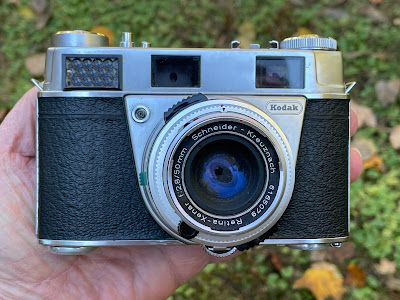 |
| Retina IIIS with an f/2.8 50mm Retina-Xenar lens |
f/4 135mm Retina-Tele-Xenar
f/4 85mm Retina-Tele-Arton
f/4 35mm Retina-Curtagon
f/4 28mm Retina-Curtagon lens and viewfinder
The lenses used the Deckel bayonet mount. The Kodak Retina Reflex S and later Kodak Retina single lens reflex cameras used the same lens mount, except some Retina SLR camera lenses would not couple to the rangefinder. Edixa Electronica and Voigtlander Bessamatic SLRs used similar lens mounts. The leaf shutter was in the camera body behind the lens. Lenses had the focusing ring, the aperture diaphragm and moving depth of field indicators. The aperture was set using a small wheel on the bottom of the lens mount and was transmitted to the iris diaphragm in the lens by a lever. You would set the shutter speed, then turn the aperture setting wheel to set the aperture Once set, the aperture was coupled to the shutter speed; changing the shutter speed would also adjust the aperture to keep the exposure constant. The ring that displayed the aperture was on the lens mount. The lenses had a front bayonet fitting for lens accessories. A cam on the lens sent the focal distance to the rangefinder by a pin in the lens mount. A collar around the pin sent the frame line selection to the viewfinder.
The shutter was a Synchro-Compur behind-the-lens leaf shutter, with speeds from 1 second to 1/500 second plus Bulb. A lever on the side of the shutter switched to X-sync for electronic flash, M-sync by flash bulbs, or V for the self timer. The shutter release was on the body and was threaded for a cable release. The film advance and shutter were interlocked to prevent accidental blank frames or double exposures. To make a multiple exposure the photographer would press and hold the rewind clutch burtton while advancing the film.
The light meter used a galvanometer powered by a selenium cell and did not need batteries. An index needle on the light meter was coupled to the shutter and aperture settings. Matching the index needle to the galvanometer needle by changing the shutter speed and aperture would set the exposure. Unlike the previous Retina IIIC, the photographer did not have to manually transfer the meter reading to the lens. The film speed was set by pressing a button on the top of the meter and turning the aperture wheel.
The film counter was manually set to the number of exposures on the film and counted down. The counter was set by pressing the film counter release and wiggling the setting button back and forth. Otherwise, loading the film was the same as most 35mm cameras.
To rewind the film the photographer pushed the rewind clutch button and turned the rewind knob. The rewind clutch button would speed while the film was being rewound and stopped spinning when the film leader came off the take-up spool.
The IIIS was a hefty camera, weighing nearly 2 pounds, and much larger than the original folding Retina of 23 years earlier.













No comments:
Post a Comment